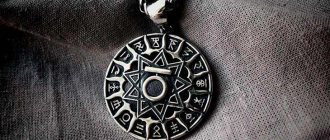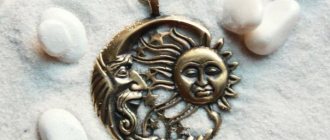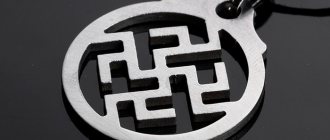The bear is a symbol of strength, courage and perseverance.
As a unique animal, the symbol of the bear is extremely popular in the legends of many cultures around the world.
The bear is an omnivore, similar to people because it eats roots, nuts, honey, berries, bird eggs and herbs.
Primitive man began to identify himself with the bear for several reasons. From early times, when people were hunters and gatherers, they respected and feared the bear, and sometimes even worshiped it because, despite being a predator, it had strength.
Bear symbol of Russia
To be precise, the symbol of Russia is a double-headed eagle. But abroad, Russia is firmly associated with the bear. Let's figure out why this opinion has developed.
The bear was always held in high esteem by the Slavs. He was considered a totem animal.
Also in the Middle Ages, buffoons traveled throughout Rus' with tame bears. The animals were trained to dance, perform simple tricks and beg.
Under Ivan the Terrible, a terrible execution was common: a bear was released on the condemned person. Sometimes the condemned person was sewn into the skin of a bear. Then they set dogs on him. Enraged dogs tore the bear's skin and killed the condemned man.
For Ivan the Terrible, watching this was his favorite pastime. Russia has always been lucky with its rulers. In this case, with a mentally ill person.
The stupid claim that bears roam the streets of Russia arose from a tragic incident. In 1526, the Austrian diplomat Sigmund von Herberstein observed how hungry bears walked through the streets of Russian cities in search of food. They tried to break into residents' houses.
This is how the myth was born that bears roam the streets of Russia.
The brown bear is very common in Russia
Russia supplied bear fat to Europe. It was especially valued in England (as a remedy for baldness). Some local merchants sold regular pork fat as bear fat. In this way they profited from the naivety of the English rich.
Another reason why Russia was associated with bears in the eyes of Europeans was the famous bear academy founded in the 17th century in the city of Smorgon. In reality it was just a private school that trained circus bears throughout Europe. The city of Smorgon at that time was part of the Polish-Lithuanian Commonwealth. But the Europeans believed that since the city was located in the east, it meant it was in Russia.
It is therefore not surprising that when England began producing political cartoons and engravings in the 19th century, Russia was always depicted as a bear.
Feature of the year
A distinctive feature of these years is the beginning of significant events. During these years, revolutions in the state are possible. For people, these are difficult tests in life, a kind of test of endurance. Very often at this time irreparable mistakes are made that affect the rest of one’s life and change it radically. The events that take place during these years lay the foundation for future changes.
This year everything secret becomes clear. During these years, people are subject to hatred that has no explanation. In the year of the Polar Bear, magic and healing flourish with increased power. Those who withstood what was happening at this time with dignity and did not suffer significant losses acquire karmic memory and can foresee future events.
Bear as a symbol of the 1980 Olympics
In 1979, the USSR sent troops to Afghanistan. Anti-Soviet hysteria began in the West. The USSR was portrayed as a bloodthirsty beast that seeks to destroy all of humanity.
To destroy this stereotype, the organizers of the Olympics decided to create the image of a cheerful and pleasant bear cub.
The Olympic bear touched all the guests of the 1980 Olympics
The organizers coped with their task perfectly!
Patron (Ized)
The Ized of the Polar Bear is considered to be Angraosha. This is the Infinite Light that pours from the sky onto everyone, illuminating souls and their innermost secrets.
Symbolism of the sign
The symbolism of this totem is cruelty and harmful influence.
Years of the totem
This is the twenty-sixth year of the Zoroastrian violet cycle. The Year of the Polar Bear follows the Year of the Donkey. People born in 1931, 1963, 1995, 2027, 2059 are under the protection of the Polar Bear totem. The symbol of the zodiac sign is the light that illuminates the soul and its innermost secrets.
Bear in the mythology of other peoples
Bear symbol in China
In China, during the Han Dynasty, people worshiped bears. This symbol was so popular that the bear became the totem animal for the country.
The funny panda quickly became a symbol of China
Pandas are well known in the region and people consider them a symbol of prosperity and abundance.
Bear symbol in feng shui
In Feng Shui, a bear is a man.
Bear figurines placed near the front door serve as guardians for everyone who is there. For those expecting a baby, keeping a bear statue is one way to ensure the health of the baby (usually a boy).
American Indian bear symbol
Among Native Americans, the bear was considered a symbol of wisdom, strength and healing. Tribes wore bear amulets and fetishes for good luck and in order to always have the power of the bear Spirit with them.
Bear as a symbol among the Celts
Celtic tradition weaves many different animal symbols into a single mythology. One example is Arti, the goddess of wildlife who took the form of a bear. It is believed that hunters invoked her spirit for success.
The bear was considered a protective parent, so bear claws often became amulets and talismans.
For the Celts, the bear was a symbol of strength
For the Celtic warrior, choosing the bear as his personal totem animal allowed him to draw strength to protect his clan or tribe.
And also charge yourself with energy for the battle, strengthen your will and personal energy to withstand the “battle”.
Celtic warriors also viewed the bear as an animal ally when dealing with authority.
Bear amulets
The symbolism of the bear, as well as certain parts of its body (tooth, claw, paw), are used as an amulet and/or amulet.
But I want to warn you - among the Slavs it is not customary to kill a totem animal!!!
The bear tooth and bear claw amulet were originally used in natural magic. A warrior who himself fought a bear and defeated it in a fair fight had the right to wear them. Evidence and symbol of this victory was a tooth or claw. In this case, the power of the bear merges with the power of the hunter, the animal, as it were, becomes his protector in the subtle world, protects him from dark influence, and helps in further battles.
A warrior could wear a tooth or claw of a bear himself, or he could give it to those people whom he wanted to take under his protection. And to whom he planned to pass on his fighting and hunting qualities - children, mainly boys, sons.
Now attempts are being made to use such amulets and amulets. But, often, these are just fashionable symbols that direct your attention to certain aspects of the world and life. They can inspire you, they can attract attention to you, including from entities of the subtle world. Some of them will want to test your strength.
Therefore, unless you have true bear qualities and are not ready for battle, do not take the tooth and claw of this animal into your field. The bear will not forgive you for your weakness.
The bear's paw amulet is a strong talisman for the home and babies, especially males. In order for it to work, it is necessary that the bear be a tribal, family totem. Or for the protection to be placed by a knowledgeable person who knows how to invite the Spirit of the bear, tie it to the family, the individual.
It is then that the paw protects from the evil eye, from evil, and initially forms true bear qualities in the protected space or person.
Bearskin
This is a special piece of home furnishings, valued among forest hunters as a trophy.
If to this day the image of a bear is revered and serves as an indicator of fortitude and courage, then the presence of a natural bear skin testifies to the masculinity of its owner. After all, only a hunter whose strength and dexterity exceeded that of a bear could hunt this beast.
And only a fairly wealthy person with a high social status could buy a bear skin >>>.
They also say that this trophy has magical properties and acts as a talisman, providing the owner with protection from evil spirits!
Other articles on the topic “Totems”
Tags: Talismans and amulets, Totems of birds and animals
- Related Posts
- Octopus - symbol and totem
- The hare is a symbol and totem
- Animal – brand, logo and mascot
Discussion: 5 comments
- Olesya:
05/15/2019 at 21:50A wonderful article with one “but”. A note from a philologist who studied folklore and traditions and customs of the peoples of Russia: killing a totem animal is taboo.
Answer
Admin:
05/15/2019 at 22:49
Olesya, thank you for your comment. I included it in the article.
Answer
08/16/2019 at 01:56
The Bear totem forces you to pay attention to how you think, how you behave and interact with the world around you, pushing you to use discernment in everything you do, discerning things with great care and attention.
Answer
10/16/2019 at 07:35
The bear is a very ancient symbol. In recent centuries, it was associated with Veles (brown), and earlier with Mokosh (polar). – Because it was an Arctic country?
- Yes. The word “Arctic” is also borrowed from Russian. Here I will again make a small digression. The fact is that the word “bear” is very often banned. Hunters think that if you say we are going to hunt a bear, he will hear it and you will never find him. That's why they say "He", "Himself". - “Who are you going to?” - “To the Master.” That is, they won’t tell you who. But the word bear is also a euphemism, a replacement for a forbidden word. Means "Connoisseur of Honey".
- He knows what to do with honey.
- Yes exactly. Before that, as you know, it was called “Ber”. And “den” is “Ber’s lair”. And both German and English borrowed it from here.
– Berlin with the sign of a bear, the most lairing place in Europe.
- Absolutely right. But ber, it’s just the word “brown”, based on color. Before that, it was called “rykas”.
- Oh, I didn't know that.
- I didn’t know either. I just read it. From the word "roar". That is, roarer, roarer, whatever. Rykas. Now that the Greeks started reading... Well, you know, like the Abkhazians, they can’t say “shop,” they write “amagazin.” They cannot say “stall”, but write “alariok”. So it is here. The Greeks could not say “rykas”, they pronounced it with the letter A at the beginning of the word, “arktos”. That is, this is the same “roarer”. Makosh's stone lies in the north, she is connected with the north, she came from the north. Therefore, everything connected with Ursa Minor, everything north and the bear... By the way, on early maps of the sky they are also there, they were made in the temple of Rod. I don’t know if you’ve seen my book, “Sacred Stones and Pagan Temples of the Ancient Slavs.” That’s where I’m showing early maps of the starry sky, and there are the constellations “Little Makosh” and “Big Makosh”. And of course, Malaya Makosh was more loved, because, as you know, Alpha in Malaya Mokosh is the North Star.” https://veche.razved.ca/main/432-bogi-menyayutsya-otvety-valeriya-chudinova-mihailu-zadornovu.html
Answer
10/16/2019 at 07:37
BEARS and SAINTS. Alexander Pyzhikov
Answer
The ambiguous image of a clubfoot
The clumsy bear is the main character of many Russian fairy tales. Moreover, his image in them is very ambiguous. So, in the fairy tale “The Man and the Bear,” a smart man outwitted an insidious beast and he was left “a fool.” And in the fairy tale “The Three Bears,” on the contrary, the main characters show the girl Masha, who has invaded the house, that they are the masters of their territory and Masha must obey and respect them.
The ambiguity of the image of a bear can also be found in Christianity. A bear is often depicted next to Elder Seraphim of Sarov. It is known that he loved these animals very much, considering them a symbol of Christian mercy and love. At the same time, in the Revelation of John the Theologian, “bear paws” are a symbol of the devil himself.
Coats of arms with the image of a bear
A special place is given to clubfoot in heraldry. There are three coats of arms with these animals, and the oldest of them appeared in 1565 and belongs to Veliky Novgorod. The coat of arms depicts a mayor, with a bear on one side and a lynx on the other. The animals represented the city guards. Later, instead of a lynx, they began to depict a second bear.
The main symbol of the Yaroslavl coat of arms is a bear. He is depicted on his hind legs and holding an ax on his shoulder. And here's why: when Yaroslav the Wise came to this land, he was attacked by a wild bear, which the pagans unleashed on the prince. But Yaroslav the Wise was not afraid and hacked the beast to death with an axe. Subsequently, the winner founded the city called today Yaroslavl.
And the third coat of arms - Perm - is decorated with an image of a bear with a Christian cross and the Bible. The coat of arms symbolizes the process of the formation of Christianity in Rus'.











